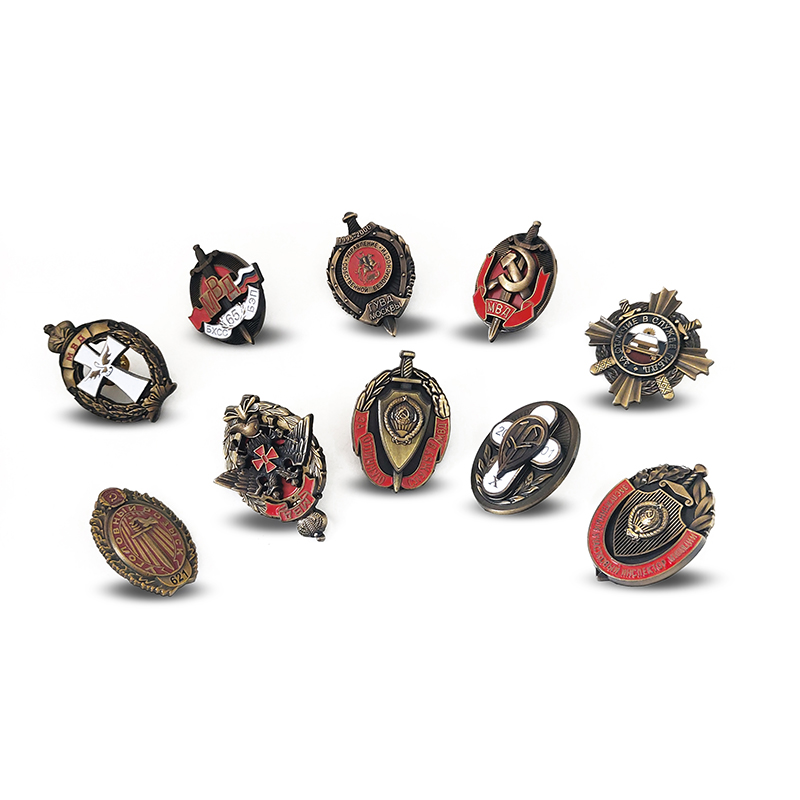
The badge material can be divided into two kinds: metal material and non-metal material. Metal materials include iron, copper, stainless steel, zinc alloy, gold, silver, etc., and non-metal materials include plastic, acrylic, plexiglass, PVC soft glue, etc. Let's talk about the characteristics of anti-corrosion badge materials.
1. High-specific strength
Only 60% of steel, the density of titanium alloy is generally around 4.5g/cm3. The strength of pure titanium is close to that of ordinary steel, and some high-strength titanium alloys exceed the strength of many alloy structural sheets of steel. Therefore, the specific strength (strength/density) of titanium alloy is much greater than that of other metal structural materials, and parts and components with high unit strength, good rigidity, and lightweight can be produced. Titanium alloys are used in aircraft engine components, skeletons, skins, fasteners, and landing gear.
2. High thermal strength
The required strength can still be maintained at moderate temperatures, and the operating temperature is several hundred degrees higher than that of aluminum alloys. These two types of titanium alloys still have high specific strength in the range of 150 ℃ ~ 500 ℃, while the specific strength of aluminum alloys decreases significantly at 150 ℃. The working temperature of titanium alloy can reach 500 ℃, and the working temperature of aluminum alloy is below 200 ℃.
3. Good corrosion resistance
Its corrosion resistance is far superior to that of stainless steel; its resistance to pitting corrosion, acid corrosion, and stress corrosion are particularly strong; it has excellent corrosion resistance to alkali, chloride, chlorine, organic substances, nitric acid, sulfuric acid, etc. However, titanium has poor corrosion resistance to media with reducing oxygen and chromium salts. Titanium alloys work in humid atmospheric and seawater media.
4. Good low-temperature performance
It still maintains its mechanical properties. Good low-temperature performance, titanium alloys at low and ultra-low temperatures. Titanium alloys with very low interstitial elements, such as TA 7, can still maintain certain plasticity at -253 °C. Therefore, titanium alloy is also an important low-temperature structural material.
5. High chemical activity
It has a strong chemical reaction with O N H CO CO2 water vapor and ammonia gas in the atmosphere. When the carbon content is greater than 0.2%, the chemical activity of titanium is large. It will form hard TiC in titanium alloy. When the temperature is high, it will also form a hard surface layer of TiN when it interacts with N; when the temperature is above 600 ℃, titanium absorbs oxygen to form a hardened layer with high hardness; the increase of hydrogen content will also form embrittlement Floor. The depth of the hard and brittle surface layer produced by absorbing gas can reach 0.1 0.15 mm, and the hardening level is 20% to 30%. The chemical affinity of titanium is also large, and it is easy to adhere to the friction surface.
6. Small thermal conductivity and elastic modulus
It is not suitable to make slender rods and thin-walled parts. The thermal conductivity of titanium is about 1/4 of nickel, 1/5 of iron, and 1/14 of aluminum, and the thermal conductivity of various titanium alloys is higher than that of titanium. about a 50% drop. The elastic modulus of titanium alloy is about 1/2 of that of steel, so its rigidity is poor and it is easy to deform. When cutting, the spring back of the machined surface is very large, which is about 2 or 3 times that of stainless steel, resulting in severe friction, adhesion, and bonding wear on the flank of the tool.
Article from www.asnypins.com


